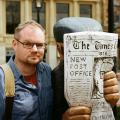
A £4.6million pound plan to transform Dumbarton’s oldest building into a library and museum has taken a step forward.
The infrastructure, regeneration and economic development (IRED) committee approved launching a public consultation on the future of the B-listed Glencairn House on the High Street.
It would be reborn as the new library for the town, while converting the existing library into a showcase for some of West Dunbartonshire’s museums collections which largely remain hidden from view.
The public will be asked about their views on the idea for three weeks from May 27, including drop-in sessions in the area.
Councillors will make a formal decision on the future of the buildings in August.
This week the members of IRED were in praise of the ideas, which would give Glencairn dedicated spaces for children and families, computer use and quiet study, coffee station, improved physical access and internal lifts.
There would also be a four-storey glass extension to the back of the building with views across the River Leven and Dumbarton Castle.
Committee chairman Councillor Iain McLaren said: "I think it's a really exciting proposition."
And Councillor Martin Rooney added: "This is an absolutely fantastic idea. Most people will see the potential benefit of an old building brought back into use."
Read more: £4.6m plan to transform historic Dumbarton building into library and museum
Malcolm Bennie, the council's strategic lead for communications, culture and communities, told the committee: "The building is an asset which the council needs to find a new purpose for."
Some of the items currently not on display in the museums collections include a Roman medallion from 193AD, one of only six cast bronze bells from the early Christian church in Scotland and the company seal for the Dumbarton Glassworks.
Richard Cairns, the strategic director of regeneration, environment and growth, said he would be disappointed if Glencairn's transformation wasn't recognised with national awards as the council's new Church Street offices have been.
"The work we have done on this building demonstrates what we can do," he said.
The library was originally in the High Street back in the 1830s. The current space in Strathleven Place would open access to objects and documents in the local heritage collection.
That includes papers on the history of the area, such as a letter under the Privy Seal of James III, a charter signed by Mary Queen of Scots, and a commission by King James VI to the baillies of Dumbarton to apprehend and try persons suspected of witchcraft, signed by the King himself.
Councillors on the committee backed the consultation phase for the plans unanimously.



Comments: Our rules
We want our comments to be a lively and valuable part of our community - a place where readers can debate and engage with the most important local issues. The ability to comment on our stories is a privilege, not a right, however, and that privilege may be withdrawn if it is abused or misused.
Please report any comments that break our rules.
Read the rules here